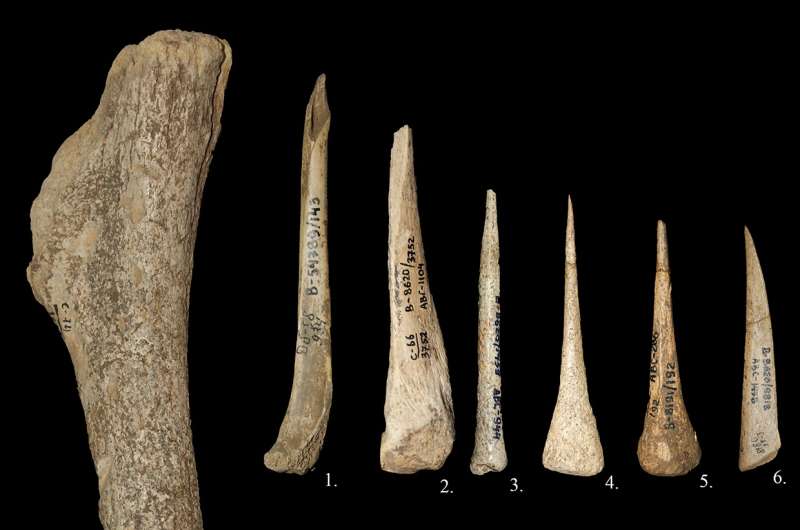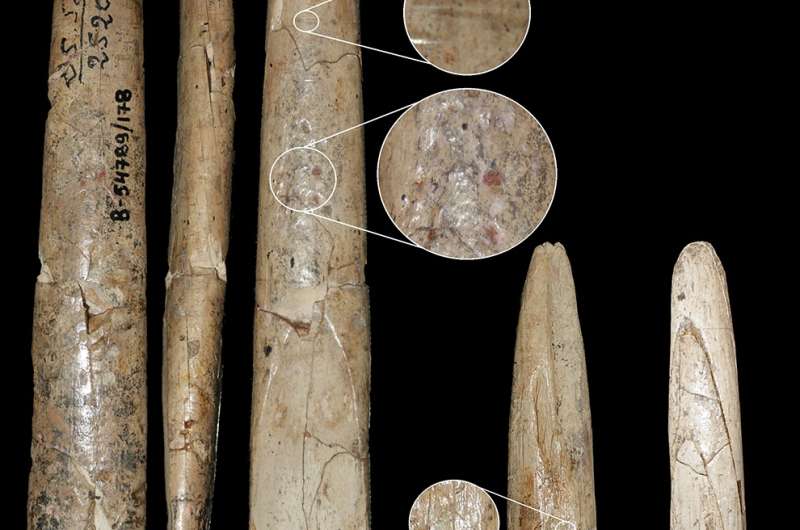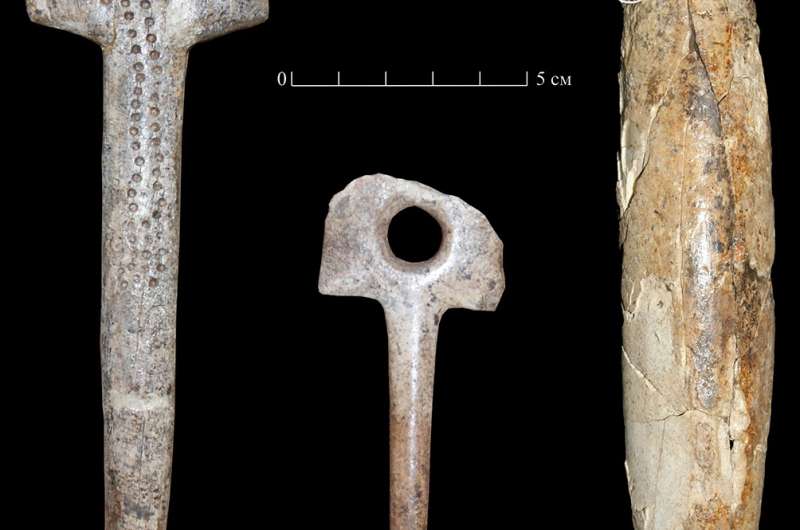Bone industry of the Sungir site: 1-5. Credit: Taisiya Soldatova
Archaeologists from the Lomonosov Moscow State University have studied objects made of bone, antler and ivory, that were found at the open-air Upper Paleolithic Sungir archaeological site in Russia. They learned how Homo sapiens processed solid organic materials and produced tools and ornamentals. The work was published in a specialized digest Hugo Obermaier Society for Quaternary Research and Archaeology of the Stone Age.
The work has established that Sungir was the base camp for ancient people, by contrast to the encampment Rusaniha located eight kilometers away from Sungir. One of the authors, Taisiya Soldatova, also reports that further study of the items found in the stand may help to determine the purpose of the monument in the Upper Paleolithic of Europe.
Sungir is located near Vladimir city. It was discovered in 1955, during preparation work for the construction of a plant, and investigated by an expedition under the leadership of famous Soviet archaeologist Otto N. Bader. He found a complicated funerary complex, consisting of two graves, each containing two burials. The burials were accompanied by a rich inventory including a large amount of products made of ivory—beads, bracelets, spears, etc.
Radiocarbon analysis determined the biological age of the fossils and biological materials, and showed that the Sungir findings are probably from 28,800 ± 240 to 25,500 ± 200 BP. According to other data, the site is about 30,000 years old.
The instruments of hunting: 1, 3 - points; 2, 4 -blanks forpoint. Credit: Taisiya Soldatova
During the collaborative work, Taisiya Soldatova conducted a study of 171 items of bone, antler and ivory (including working and hunting tools, blanks for various purposes and waste materials), while Vladislav Zhitenev focused his attention on the ornamentals—pendants made of Arctic fox teeth and beads of ivory.
"The main objective of the study is to examine the products made of solid organic materials (bone, antler and ivory) from the Sungir Upper Paleolithic site. Together with stone tools, working bone is an important indicator of cultural attribution, and can also play a significant role in addressing some of the relative chronology issues," says Taisiya Soldatova.
According to the specialist, technological analysis of the Upper Paleolithic sites of the Vladimir region showed that Sungirian man had mastered quite a wide range of techniques for processing bone material—longitudinal and transverse fracture, transverse break with preparatory sawing, cutting, sawing, planing/scraping. All of these techniques have been used to create collections of bones, antler and ivory, so it is possible to call it a rather uniform treatment of solid organic materials by Sungirian man.
Ivory tools from Sungir stand burials: 1,2 - "shaft straighteners"; 3 - "retoucher". Credit: Taisiya Soldatova
On the other hand, the study showed that working with bone and antler is different than working with ivory: Ivory tools and ornaments are better formed than bone and antler. Moreover, no ivory tools were used in household activity; just hunting weapons, art objects and ornaments. The collection contains three items of ivory that can be called tools: a "retoucher" and two "shaft straighteners." However, it should be emphasized that these instruments of ivory were found in burials and may have a symbolic meaning.
These peculiarities of ivory processing suggest some parallels between Sungir and early Aurignacian sites of European Upper Paleolithic culture. This raw material became ornaments and small figurines, and, in rare cases, points with massive bases. Thus, it can be assumed that the bone industry of Sungir was culturally influenced by early Aurignac, which resulted in similar categories of tools, as well as the nature of the ivory material use. On Sungir, a high percentage of objects from antler (16 percent) was found, which resembles findings from Central and Western European sites of the Upper Paleolithic.
Among the investigated items, there are finds of varying completion—from blanks to finished products. Therefore, the researchers suggest that the treatment of bone material happened at the site. In addition, the functional variety of findings proves that in Sungir, which covered an area of over 4,000 km2, economic activities were conducted: Evidence of manufacturing clothing from animal skins was confirmed by awls and pins; hoe-like tools suggest excavation work. Archaeologists also found chisels and points—this could mean that Sungir people paid attention to productive activities and hunting, particularly deer, mammoths, wolves and wild horses. In other words, Sungir was probably the base camp, as opposed to nearby Rusanikha. The head of the Rusanikha excavations, L.A. Mikhailova, suggests that the stand was an encampement of mammoth hunters because of the predominance of stone hunting tools and animal bones.
"Comparing bones, antler and ivory objects from Sungirwith European collections of the Early Upper Paleolithic sites can help identify the cause of differences in methods of treating various bone material, and finding the similarities may help define common features in the nature of bone industries of this age and determine the place of the researched site in the Upper Paleolithic of Europe," Taisiya Soldatova says.
Provided by Lomonosov Moscow State University

























